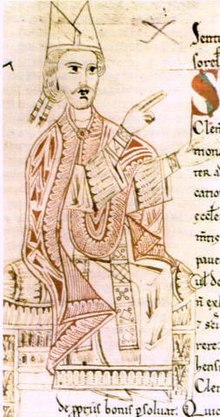Pope Gregory VII
|
Pope Saint Gregory VII |
|
|---|---|
 |
|
| Papacy began | 22 April 1073 |
| Papacy ended | 25 May 1085 |
| Predecessor | Alexander II |
| Successor | Victor III |
| Orders | |
| Ordination | 22 May 1073 |
| Consecration | 30 June 1073 |
| Created Cardinal | 6 March 1058 by Pope Nicholas II |
| Personal details | |
| Birth name | Ildebrando di Soana |
| Born | c. 1015 Sovana, Tuscany, Holy Roman Empire |
| Died | 25 May 1085 Salerno, Duchy of Apulia |
| Previous post | Cardinal-Deacon of Santa Maria Domnica (1058–73) |
| Sainthood | |
| Feast day | 25 May |
| Venerated in | Roman Catholic Church |
| Beatified | 1584 by Pope Gregory XIII |
| Canonized | 24 May 1728 by Pope Benedict XIII |
| Attributes |
|
| Patronage | Diocese of Sovana |
|
Papal styles of Pope Gregory VII |
|
|---|---|
 |
|
| Reference style | His Holiness |
| Spoken style | Your Holiness |
| Religious style | Holy Father |
| Posthumous style | Saint |
| Pope Saint Gregory VII | |
|---|---|

An engraving of Pope Gregory VII saying Mass, from Little Pictorial Lives of the Saints (1878)
|
|
| Pope | |
| Born | C. 1020 Sovana |
| Died | 25 May 1085 Salerno |
| Venerated in | Roman Catholic Church |
| Beatified | 1584, Rome, Papal States by Pope Gregory XIII |
| Canonized | 24 May 1728, Rome, Papal States by Pope Benedict XIII |
| Feast | 25 May |
| Attributes |
|
| Patronage | Diocese of Sovana |
Gregory VII (Latin: Gregorius VII; c. 1015 – 25 May 1085 AD), born Hildebrand of Sovana (Italian: Ildebrando da Soana), was Pope from 22 April 1073 to his death in 1085.
One of the great reforming popes, he is perhaps best known for the part he played in the Investiture Controversy, his dispute with Henry IV, Holy Roman Emperor that affirmed the primacy of papal authority and the new canon law governing the election of the pope by the College of Cardinals. He was also at the forefront of developments in the relationship between the emperor and the papacy during the years before he became pope. He was the first pope in several centuries to rigorously enforce the Western Church's ancient policy of celibacy for the clergy and attacked the practice of simony.
He excommunicated Henry IV three times. Consequently, Henry IV would appoint Antipope Clement III to oppose him in the political power struggles between the Catholic Church and his empire. Hailed as one of the greatest of the Roman pontiffs after his reforms proved successful, Gregory VII was, during his own reign, despised by some for his expansive use of papal powers.
The Pope having been such a prominent champion of papal supremacy, his memory was evoked on many occasions in later generations, both positively and negatively, often reflecting later writers' attitude to the Catholic Church and the papacy. Beno of Santi Martino e Silvestro, who opposed Gregory VII in the Investiture Controversy, leveled against him charges such as necromancy, torture of a former friend upon a bed of nails, commissioning an attempted assassination, executions without trials, unjust excommunication, doubting the Real Presence of the Eucharist, and even burning the Eucharist. This was eagerly repeated by later opponents of the Catholic Church, such as the English Protestant John Foxe.Joseph McCabe describes Gregory as a "rough and violent peasant, enlisting his brute strength in the service of the monastic ideal which he embraced." In contrast, the noted historian of the 11th century H. E. J. Cowdrey writes, "[Gregory VII] was surprisingly flexible, feeling his way and therefore perplexing both rigorous collaborators ... and cautious and steady-minded ones ... His zeal, moral force, and religious conviction, however, ensured that he should retain to a remarkable degree the loyalty and service of a wide variety of men and women."
...
Wikipedia
